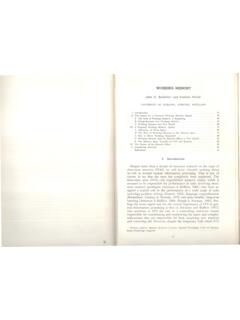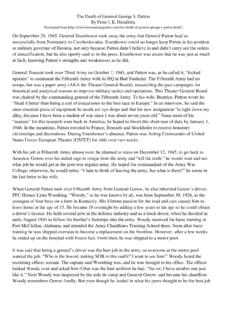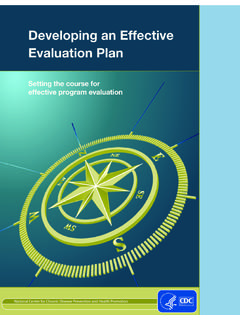Transcription of Stufflebeam's (IPP Evaluation Model Defining Evaluation
1 CHAPTER 10 Evaluation in Instructional Design: A Comparison of Evaluation Models 97. the 1960s and early 1970s, all had an Evaluation compo- Scriven (1980) also provides a "logic of Evaluation ". nent. Most included the formative/summative distinction that includes four steps. First, select the criteria of merit or and suggested that designers engage in some process in worth. Second, set specific performance standards ( , the which drafts of instructional materials are studied by learn- level of performance required) for your criteria. Third, col- ers and data are obtained on learners' performance on tests lect performance data and compare the level of observed and their reactions to the instruction. This information and performance with the level of required performance dic- data were to be used to inform revisions. tated by the performance standards. Fourth, make the eval- The Evaluation processes described in early instruc- uative ( , value) judgment(s).
2 In short, Evaluation is tional design models incorporated two key features. about identifying criteria of merit and worth, setting stan- First, testing should focus on the objectives that have dards, collecting data, and making value judgments. been stated for the instruction. This is referred to as criterion-referenced (or objective-referenced) testing. The argument is made that the assessment instruments Models of Program Evaluation for systematically designed instruction should focus on Many Evaluation models were developed in the 1970s and the skills that the learners have been told will be taught 1980s. 1 These Evaluation models were to have a profound in the instruction. The purpose of testing is not to sort the impact on how designers would come to use the Evaluation learners to assign grades, but rather to determine the process. The new models were used on p;ojects that in- extent to which each objective in the instruction has cluded extensive development work, multiple organiza- been mastered.
3 Assessments, be they multiple-choice tions and agencies, and mUltiple forms of instructional items, essays, or products developed by the learners, delivery. These projects tended to have large budgets and should require learners to demonstrate the skills as they many staff members, and were often housed in universities. are described in the objectives in the instruction. The projects had multiple goals that were to be achieved The second feature is a focus on the learners as the over time. Examples were teacher corps projects aimed at primary source of data for making decisions about the in- reforming teacher education and math projects that at- struction. While subject matter experts (SMEs) are typi- tempted to redefine what and how children learned about O ne of the fundamental components of instructional design models is Evaluation . The purpose of this Several leaders in the field of educational psychology and Evaluation , including Lee Cronbach and Michael cally members of the instructional design team, they cannot always accurately predict which instructional strategies mathematics.
4 These projects often employed new models of Evaluation . Perhaps the most influential Model of that era chapter is to describe several of the most influential and Scriven, recognized that the problems with this approach will be effective. Formative Evaluation in instructional was the CIPP Model developed by Stufflebeam (1971). useful Evaluation models. to instruction should have been discovered sooner. The design should include an SME review, and that of an edi- The Evaluation of educational innovations in the 1950s debate that followed resulted in a bipartite reconceptual- tor, but the major source of input to this process is the Stufflebeam's (IPP Evaluation Model and 1960s usually consisted of research designs that ization of educational Evaluation , and the coining of the learner. Formative Evaluation focuses on learners' ability to involved the use of experimental and control groups.)
5 A terms formative and summative Evaluation by Michael The CIPP acronym stands for context, input, process, and learn from the instruction, and to enjoy it. posttest was used to determine if the experimental group Scriven in 1967. Here are Scriven's (1991) definitions of product. These are four distinct types of Evaluation , and that received the instruction did significantly better than formative and summative Evaluation : they all can be done in a single comprehensive Evaluation the control group, which had received no instruction. This or a single type can be done as a stand-alone Evaluation . Formative Evaluation is Evaluation designed, done, and in- Defining Evaluation approach was used to determine the effectiveness of new tended to support the process of improvement, and normally Context Evaluation is the assessment of the environ- instructional innovations such as educational television commissioned or done by, and delivered to, someone who Before we continue with our development of Evaluation in ment in which an innovation or program will be used, to and computer-assisted instruction.
6 In these studies, the ef- can make improvements. Summative Evaluation is the rest of instructional design, we provide a formal definition of determine the need and objectives for the innovation and fectiveness of instruction delivered via the innovation was Evaluation : in terms of intentions, it is Evaluation done for, Evaluation . Because of the prominence of Scriven in eval- to identify the factors in the environment that will impact compared to the effectiveness of "traditional instruction," or by, any observers or decision makers (by contrast with uation, we will use his definition (Scriven, 1991): the success of its use. This analysis is frequently called a which was usually delivered by a teacher in a classroom. developers) who need evaluative conclusions for any rea- needs assessment, and it is used in making program plan- sons besides development. (p. 20) Evaluation is the process of determining the merit, worth, ning decisions.
7 According to Stufflebeam's CIPP Model , The major purpose of the Evaluation was to determine the and value of things, and evaluations are the products of that value or worth of the innovation that was being developed. The result of the discussions about the role of evalua- the evaluator should be present from the beginning of the process. (p. 139). In the 1960s, the United States undertook a major cur- tion in education in the late 1960s and early 1970s was an project, and should assist in the conduct of the needs riculum reform. Millions of dollars were spent on new agreement that some form of Evaluation needed to be By merit Scriven is referring to the "intrinsic value" of assessment. textbooks and approaches to instruction. As the new texts undertaken prior to the distribution of textbooks to users. the Evaluation object or evaluand. By worth, Scriven is were published, the traditional approach to Evaluation was The purpose was not to determine the overall value or referring to the "market value" of the evaluand or its value invoked; namely, comparing student learning with the new worth of the texts, but rather to determine how they could to a stakeholder, an organization, or some other collective.
8 1 Additional Evaluation models are being developed today, and many of By value, Scriven has in mind the idea that Evaluation the older models continue to be updated. For a partial listing of important curricula with the learning of students who used the tradi- be improved. During this developmental or formative eval- models not presented in this chapter, see Chen (1990), patton (2008), and tional curricula. While some of the results were ambigu- uation phase, there is an interest in how well students are always involves the making of value judgments. Scriven Stufflebeam, Madaus, & Kellaghan (2000). If space allowed, the next two ous, it was clear that many of the students who used the learning and how they like and react to the instruction. contends that this valuing process operates for both form- models we would include are Chen's "theory driven Evaluation " and new curricula learned very little.
9 Instructional design models, which were first published in ative and summative Evaluation . patton 's "utilization focused Evaluation .". 96. CHAPTER 10 Evaluation in Instructional Design: A Comparison of Evaluation Models 99. 98 SECTION III Evaluating and Managing Instructional Programs and Projects should also be collected about program components (such as this Model , each Evaluation should be tailored to fit local ratios used in these types of analysis are explained below The second step or component of the CIPP Model is the instructor, the topics, the presentation style, the sched~~, input Evaluation . Here, Evaluation questions are raised needs, resources, and type of program. This includes in a foomote. 4. the facility, the learning activities, and how engaged partICI- about the resources that will be used to develop and con- tailoring the Evaluation questions (what is the Evaluation pants felt during the training event).)
10 It also is helpful to duct the innovation/program. What people, funds, space, purpose? what specifically needs to be evaluated?), meth- Kirkpatrick's Training Evaluation Model include open-ended items ( , where respondents respond and equipment will be available for the project? Will these ods and procedures (selecting those that balance feasibil- Kirkpatrick's Model was published initially in fo~ ~ in their own words). 'IWo useful open-ended items are be sufficient to produce the desired results? Is the concep- ity and rigor), and the nature of the evaluator-stakeholder cles in 1959. Kirkpatrick's purpose for proposmg his (1) ''What do you believe are the three most important weak- tualization of the program adequate? Will the program relationship (who should be involved? what level of par- Model was to motivate training directors to realize the im- nesses of the program?" and (2) ''What do you believe are the design produce the desired outcomes?






